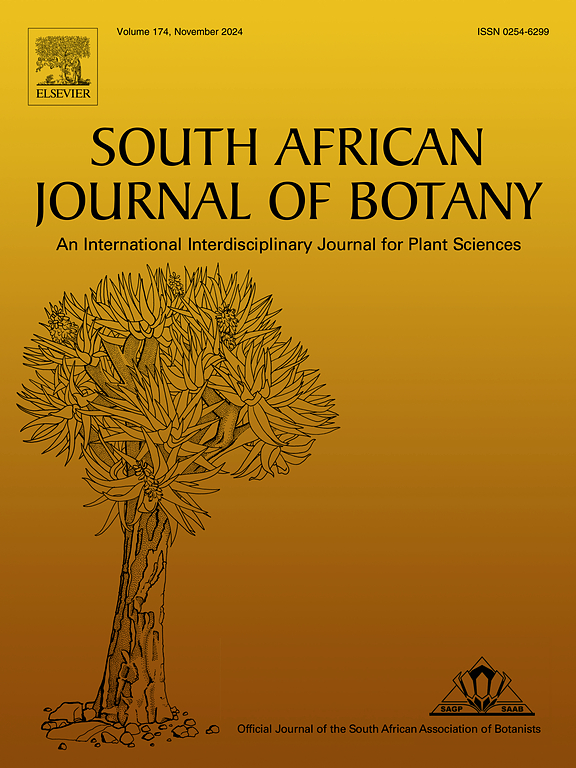Cytotoxicity, acute and subchronic toxicity of the methanol extract from the fruits of Psorospermun febrifugum Spach (Hypericaceae) in Wistar albino rats
IF 2.7
3区 生物学
Q2 PLANT SCIENCES
引用次数: 0
Abstract
Psorospermun febrifugum is used to treat a wide range of diseases, amongst which are malaria, pneumonia, skin diseases, dysmenorrhoea, dysentery, and tuberculosis. This study aimed to investigate the cytotoxicity of the methanol extract from the fruits of P. febrifugum (PFF) and its toxicological profile on Wistar rats. the cytotoxicity of the extract, fractions, and the isolated compound, harungine anthrone (1), was evaluated using the resazurin reduction assay (RRA). Acute and subchronic toxicity studies were conducted according to the experimental protocol the Organisation for Economic Cooperation and Development (OECD) described. PFF, the fractions PFFa, PFFb, PFFc, and PFFd were cytotoxic (IC50 below 20 µg/mL) towards at least one of the 9 tested cancer cell lines. The best cytotoxic effects (IC50 below 5 µg/mL) were obtained with the PFFb fraction against CCRF-CEM leukemia cells (1.55 µg/mL) and its multidrug-resistant subline CEM/ADR5000 (4.28 µg/mL), as well as MDA-MB-231-pcDNA breast adenocarcinoma cells (3.38 µg/mL). Compound 1 had moderate activity with IC50 values ranging from 26.14 µM (against HCT116 (p53+/+) colon adenocarcinoma cells) to 34.18 µM (against U87.MG glioblastoma cells. In the acute toxicity study, no deaths or signs of toxicity were recorded at 5,000 mg/kg body weight (b.w.) of rats. Subchronic toxicity studies of PFF showed some changes in biochemical parameters, including serum levels of low-density lipoproteins (LDL), high-density lipoproteins (HDL), and transaminases at 250, 500, and 1000 mg/kg b.w. Histopathological analysis of the liver and kidney did not reveal any damage in treated animals compared to controls. In conclusion, the crude extract of P. febrifugum is a source of cytotoxic drugs. It is almost safe in acute and prolonged oral administrations at doses lower than 1,000 mg/kg b.w. However, it should be taken cautiously regarding its effect on the rat's body and biochemical parameters.
金丝桃果甲醇提取物对Wistar白化大鼠的细胞毒性、急性和亚慢性毒性
温热补骨精用于治疗多种疾病,其中包括疟疾、肺炎、皮肤病、痛经、痢疾和肺结核。本研究旨在探讨白桦果实甲醇提取物对Wistar大鼠的细胞毒性及其毒理学特征。采用reazurin还原法(RRA)对提取物、馏分和分离化合物harungine anthrone(1)的细胞毒性进行了评估。急性和亚慢性毒性研究是根据经济合作与发展组织(经合组织)所描述的实验方案进行的。PFF、PFFa、PFFb、PFFc和PFFd对9种测试的癌细胞系中至少一种具有细胞毒性(IC50低于20µg/mL)。PFFb组分对CCRF-CEM白血病细胞(1.55µg/mL)及其多药耐药亚系CEM/ADR5000(4.28µg/mL)和MDA-MB-231-pcDNA乳腺腺癌细胞(3.38µg/mL)的细胞毒作用最佳(IC50 < 5µg/mL)。化合物1具有中等活性,IC50值在26.14µM(对HCT116 (p53+/+)结肠腺癌细胞)到34.18µM(对U87)之间。MG胶质瘤细胞。在急性毒性研究中,大鼠在5,000 mg/kg体重(b.w.)下未记录死亡或毒性迹象。亚慢性毒性研究显示,在250、500和1000 mg/kg b.w时,PFF的生化参数发生了一些变化,包括血清低密度脂蛋白(LDL)、高密度脂蛋白(HDL)和转氨酶水平。与对照组相比,肝脏和肾脏的组织病理学分析未发现任何损伤。综上所述,白杨的粗提物是细胞毒性药物的一个来源。在急性和长期口服剂量低于1000毫克/公斤体重时,它几乎是安全的。然而,考虑到它对大鼠身体和生化参数的影响,应谨慎服用。
本文章由计算机程序翻译,如有差异,请以英文原文为准。
求助全文
约1分钟内获得全文
求助全文
来源期刊

South African Journal of Botany
生物-植物科学
CiteScore
5.20
自引率
9.70%
发文量
709
审稿时长
61 days
期刊介绍:
The South African Journal of Botany publishes original papers that deal with the classification, biodiversity, morphology, physiology, molecular biology, ecology, biotechnology, ethnobotany and other botanically related aspects of species that are of importance to southern Africa. Manuscripts dealing with significant new findings on other species of the world and general botanical principles will also be considered and are encouraged.
 求助内容:
求助内容: 应助结果提醒方式:
应助结果提醒方式:


